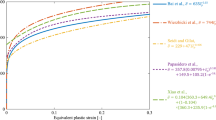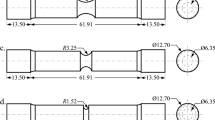Abstract
An uncoupled ductile fracture model, based on Mu–Zang model, is extended by incorporating a hydrostatic stress term. An aluminum alloy material (Al 6016-T6) is selected with a series of static ductile fracture tests performed on four different specimens, which can cover a wide range of stress states. A robust simulation-experiment approach is adopted to characterize the correlation between the material’s ductility and distinct stress states. The extended model is then calibrated using least-squares optimization. The resulting 3D fracture surface demonstrates acceptable deviations from the tested data, manifesting a promising capability of the extended model to describe the ductility of the considered material within a wide stress state range. In addition, the comparison against other representative ductile fracture models further confirms a good prediction performance of the model proposed.
Access this chapter
Tax calculation will be finalised at checkout
Purchases are for personal use only
Similar content being viewed by others
References
Li H, Fu MW, Lu J, Yang H (2011) Ductile fracture: experiments and computations. Int J Plast 27(2):147–180
Nahshon K, Hutchinson JW (2008) Modification of the Gurson model for shear failure. Eur J Mech A-Solid 27(1):1–17
Lou Y, Yoon JW, Huh H (2014) Modeling of shear ductile fracture considering a changeable cut-off value for stress triaxiality. Int J Plast 54:56–80
Bai Y, Wierzbicki T (2010) Application of extended Mohr–Coulomb criterion to ductile fracture. Int J Fract 161(1):1–20
Mu L, Jia Z, Ma ZW, Shen FH, Sun YK, Zang Y (2020) A theoretical prediction framework for the construction of a fracture forming limit curve accounting for fracture pattern transition. Int J Plast. https://doi.org/10.1016/j.ijplas.2020.102706
Mu L, Zang Y, Wang Y (2018) Phenomenological uncoupled ductile fracture model considering different void deformation modes for sheet metal forming. Int J Mech Sci 141:408–423
Qian LY, Fang G, Zeng P, Wang Q (2015) Experimental and numerical investigations into the ductile fracture during the forming of flat-rolled 5083-O aluminum alloy sheet. J Mater Process Technol 220:264–275
Hering O, Tekkaya AE (2020) Damage-induced performance variations of cold forged parts. J Mater Process Technol 279:116556
Hu Q, Li X, Han X, Chen J (2017) A new shear and tension based ductile fracture criterion: modeling and validation. Eur J Mech A-Solid 66:370–386
Quach H, Kim JJ, Nguyen DT, Kim YS (2020) Uncoupled ductile fracture criterion considering secondary void band behaviors for failure prediction in sheet metal forming. Int J Mech Sci 169:105297
Roth CC, Mohr D (2016) Ductile fracture experiments with locally proportional loading histories. Int J Plast 79:328–354
Erice B, Roth CC, Mohr D (2018) Stress-state and strain-rate dependent ductile fracture of dual and complex phase steel. Mech Mater 116:11–32
Author information
Authors and Affiliations
Corresponding author
Editor information
Editors and Affiliations
Rights and permissions
Copyright information
© 2021 The Minerals, Metals & Materials Society
About this paper
Cite this paper
Jia, Z., Mu, L., Guan, B., Zang, Y. (2021). An Extended Ductile Fracture Prediction Model Considering Hydrostatic Stress and Maximum Shear Stress. In: Daehn, G., Cao, J., Kinsey, B., Tekkaya, E., Vivek, A., Yoshida, Y. (eds) Forming the Future. The Minerals, Metals & Materials Series. Springer, Cham. https://doi.org/10.1007/978-3-030-75381-8_133
Download citation
DOI: https://doi.org/10.1007/978-3-030-75381-8_133
Published:
Publisher Name: Springer, Cham
Print ISBN: 978-3-030-75380-1
Online ISBN: 978-3-030-75381-8
eBook Packages: Chemistry and Materials ScienceChemistry and Material Science (R0)




